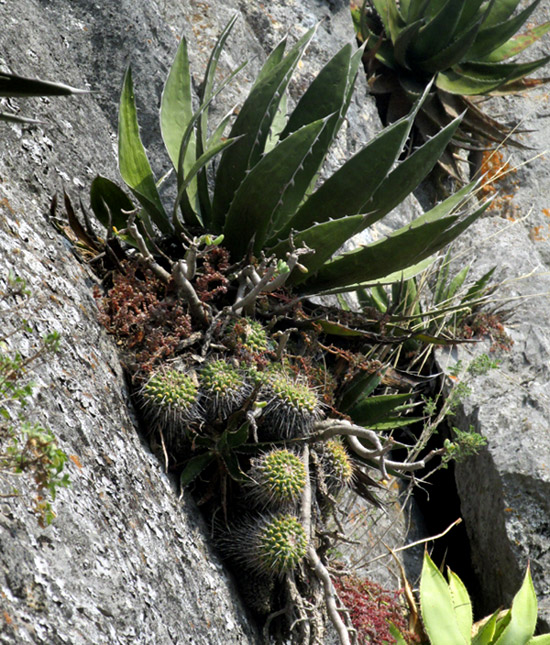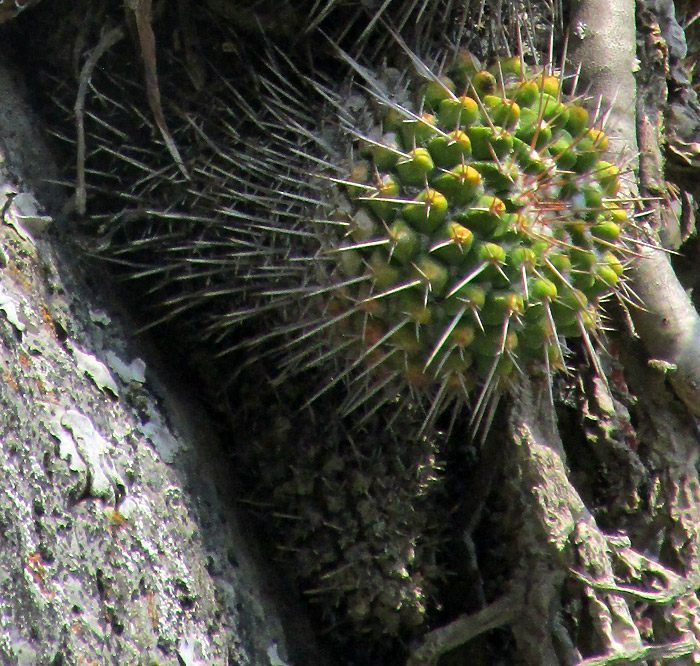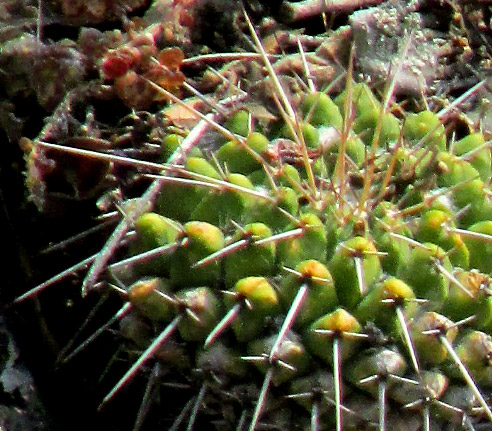Excerpts from Jim Conrad's
Naturalist Newsletter
entry from field notes dated May 5, 2023, taken about 150m uphill on NE-facing slope, above intersection of road from Hwy 120 to San Joaquín, with road to El Doctor; juniper and pine forest on limestone bedrock; elevation ±2425m (7950 ft); Eastern Sierra Madre mountains of east-central Querétaro state, MÉXICO, (N20.88°, W99.62°)
MAMMILLARIA COMPRESSA ssp. COMPRESSA

On the high wall of limestone pictured above, sometimes whole communities of plants took hold in fissures, and often the species at home there were among the most interesting in the area. However, usually they were out of reach and couldn't be closely examined. Above, the top large rosette of leaves is an agave. With its large, widely spaced white spines and white margins it's suggestive of Agave ghiesbreghtii, normally found a bit farther south than here, and apparently not documented for Querétaro. Several other succulent species cluster below the agave, but here we're profiling the cactus with several heads clustered at the picture's bottom. My camera's small telephoto lens brings us closer:

This cactus belongs to that group of cactus genera whose stem surfaces are fragmented into small mounds -- "tubercles" in cactus terminology -- with spines arising from scar-like "areoles" atop each tubercle, and the tubercles don't merge to form ridges. Many such cacti are ball-shaped, but above you can see that this cactus is conspicuously elongated. Enlarging part of the top picture, the cactus's spine arrangement shows up clearer:

On older tubercles, four or so spines typically arise in each cluster, with one spine much longer than the others, two shorter spines opposite one another arising perpendicularly to the long spine, and the shortest spine emerging more or less opposite the long one. All spines are white throughout. At the head's top, where new tubercles form, white, cottony hairs grow from between the tubercles, protecting new growth.
Among the tuberculate genera, the main field mark usually used to separate the genera is whether there's a crease-like furrow or groove to some extent running down one side of each tubercle. Sometimes the groove is hard to see, and sometimes malformed or damaged tubercles seem to have them, but don't, so that can be tricky, especially when you can't examine them closely. The next big field mark is whether, when a tubercle is cut, the sap that oozes out is watery or milky. After that, floral features are used.
In short, identifying our cactus comes down to matching our pictures with identified ones on the Internet, and confirming as well possible the ID by consulting distribution maps and technical descriptions of species halfway looking like ours.
This shaky procedure brought me to MAMMILLARIA POLYTHELE*, one of numerous Mammillaria species known as pincushions, and in Spanish by the almost indiscriminately applied name biznaga.